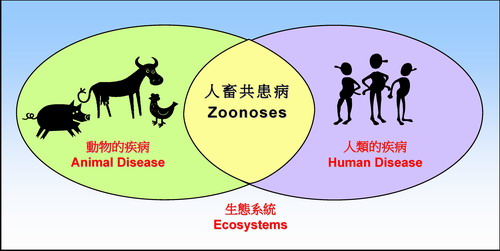
Food Safety Focus (66th Issue, January 2012) – Food Safety Platform
Zoonoses and Food Safety
Reported by Dr. Brian LI, Veterinary Officer,
Veterinary Public Health Section,
Centre for Food Safety
Zoonoses can be defined as diseases and infections naturally transmitted between vertebrate animals and humans. More than 60% of all human infections and 75% of emerging human infections are zoonotic in nature. Diagram 1 illustrates the position of zoonoses, which lies between human and animal diseases. As animals and their living ecosystems are important components of the human food chain, microorganisms could pass between human and animals within the same ecosystems. Efforts should be made to prevent diseases occurring in animals from spreading to humans.

Diagram 1. Position of Zoonoses
Possible Exposures of Zoonotic Infection Related to Food Safety
Although there are many routes by which human can get a disease from animals, working with infected food animals or consuming their food products remains the most important routes of zoonotic infection.
For Consumers
A member of the general public may have eaten food contaminated with pathogens when he eats uncooked eggs contaminated with Salmonella or unpasteurised cheese tainted with Listeria. Both microorganisms found in farm animals could pass into food along the food chain. At the same time, people may also get sick from consuming raw contaminated aquatic products. One of the notorious examples is the parasitic infestation with Clonorchis sinensis (commonly known as Chinese liver fluke) from eating raw or undercooked freshwater fish.
For Members of Trade/Industry
People working close to animals have a higher risk of contracting zoonotic diseases through direct or indirect contact with animals. A butcher could contract Streptococcus suis via lesions on his skin after contact with contaminated meat. Workers in a processing plant with improper protective clothing can be infected with Q Fever or Leptospirosis through direct or indirect contact with infectious fluid from animal carcasses. Milkers in dairy farms may get sick from contacting cattle infected with diseases such as cow pox, brucellosis, or gastrointestinal disease like E.coli.
One Health
One Health is a worldwide strategy for expanding interdisciplinary collaborations and communications in all aspects of health care for humans, animals and the environment, aiming to improve human and animal health globally. Since emerging diseases are increasingly found in animals and the environment, the concept of One Health for disease control received much attention recently. Resources such as diagnostic and research works and information are shared between both the medical and veterinary teams. With such cooperation in a food safety system, potential zoonotic pathogens are identified in animals and the environment within the food chain and efficient control and prevention of zoonotic diseases can be achieved.
To reduce the risk of zoonoses, consumers and workers dealing with animals can take heed of the following advice:
Advice to Consumers
- Wash hands properly when preparing food or after touching animals.
- Prevent cross-contamination of raw and cooked food by separating them in storage.
- Cook foods thoroughly and avoid tasting raw food.
- Store foods in proper condition according to the manufacturers' instruction if available.
Advice to Trade
- Only obtain food and ingredients from reliable sources, particularly for food animal products.
- Adopt Good Manufacturing Practice at workplace to minimise the risk of getting infection from contacting with animals or animal products.
- Provide adequate protective gear for staff in processing plant and slaughter house.
- Maintain good working environment and welfare to animals. Tidiness and comfortable temperature should be maintained so as to improve general health of both workers and animals.
- Poultry workers, pig farmers and pig-slaughtering industry personnel are recommended to receive the influenza vaccine.


